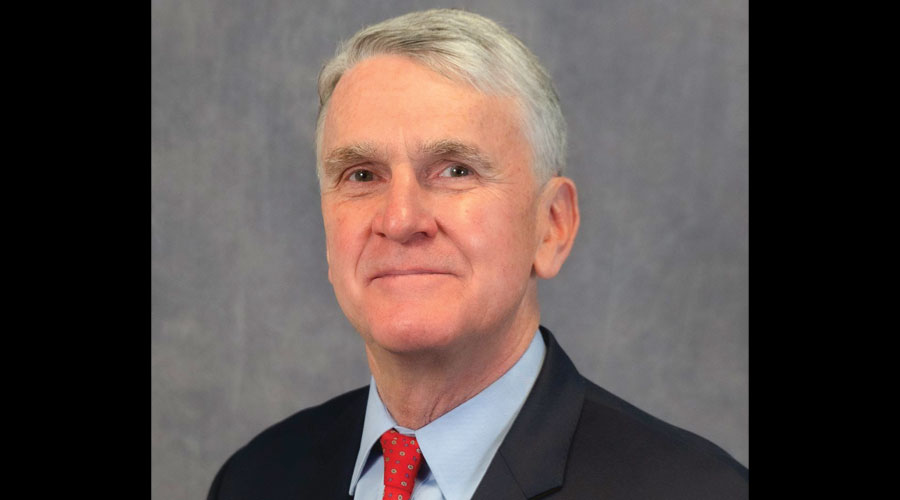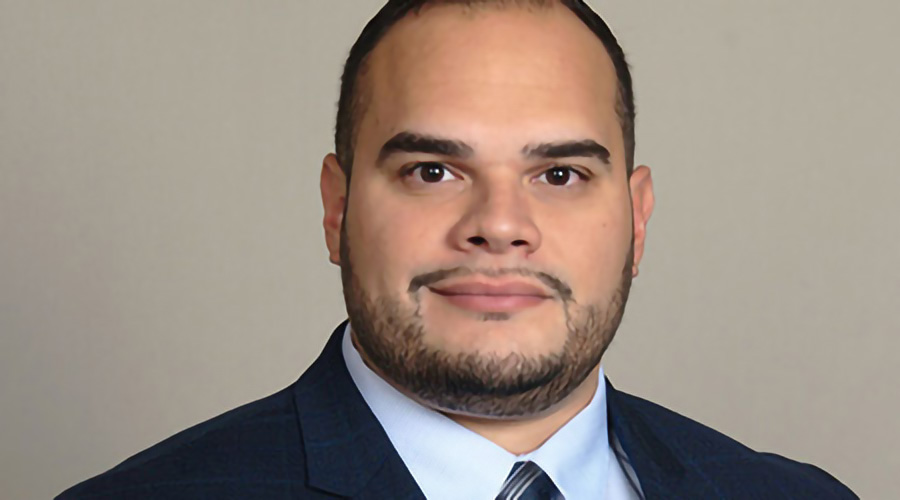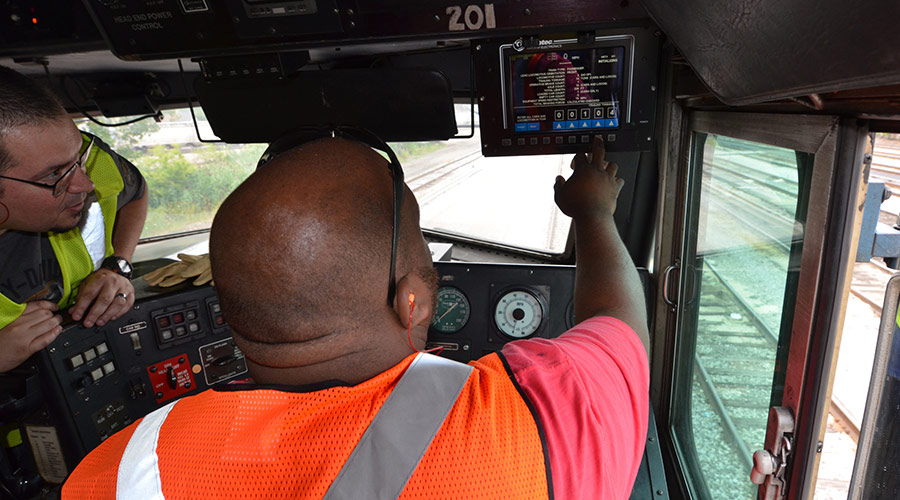Stay updated on news, articles and information for the rail industry
August 2010
Rail News: PTC
PTC: Railroads, suppliers still have a ways to go to meet the 2015 positive train control mandate
Forty-one railroads are working furiously to meet the positive train control (PTC) mandate's well-known and fretted-over D-Day of Dec. 31, 2015, when systems must be up and running on federally designated U.S. rail lines used to transport certain hazardous materials and passengers.
Job No. 1 for the Class Is, Amtrak, more than 20 commuter roads and several agencies that haven't yet launched commuter-rail service, but plan to do so by 2015's end: finalizing their implementation plans (IPs). The Federal Railroad Administration (FRA) initially received the IPs in April and last month sent letters to most of the railroads seeking clarifications and additional information by mid-August.
In addition to mapping out each railroad's plan of attack, the IPs show there will be many more jobs to pull off during the next five-plus years.
"Our implementation plan has 13,000 tasks in it," says Frank Lonegro, president of CSX Technology.
Railroads continue to face the enormous undertaking of designing, testing and installing PTC on thousands of miles of track. Collectively, they must install tens of thousands of wayside, onboard and radio devices, and at a cost exceeding — and continuing to head north of — $10 billion. Although there have been a few steps forward the past two years, railroads haven't made a lot of progress.
"We're all moving down the field, but the goal post is not in focus," says Mike Monastero, chief engineering officer-communications and signals for the Southeastern Pennsylvania Transportation Authority (SEPTA).
To ensure they reach the end zone before the clock runs out, each railroad is working on multiple fronts both alone and in conjunction with suppliers. For example, Kansas City Southern Railway Co. (KCSR) officials are simultaneously completing an audit of system specifications against operational requirements; developing configuration management processes, procedures and tools; working with vendors and service providers to engineer wayside and communication technologies; and continuing to develop a PTC safety plan.
Roads also are working with each other to make certain the dozen or so PTC systems that are being developed work as intended no matter which railroad is in control of a train.
"When CSX gets their system in place, we will get a system that works with that," says Joseph Giulietti, executive director of the South Florida Regional Transportation Authority, which operates Tri-Rail trains on CSX Transportation's track. "We have conceptually agreed on what to put in [and] we need to get a formal agreement with CSX."
But getting all 41 railroads on the same page — from interoperability to radio protocols to, in some cases, sharing PTC specifications — will take more than multi-tasking and cooperation. It'll take the acquisition of enough bandwidth, especially in major metropolitan areas, to provide frequencies for all radio equipment; pooling of enough manpower to install all the necessary components and equipment on time; and creation of training programs so workers know how to operate the systems when they're in place.
Moreover, it'll take an enormous effort from a small pool of suppliers with PTC expertise to continue helping roads develop and test the myriad of wayside, onboard and back-office components, and ensure everything works.
"The capacity of suppliers to feed the need of all the railroads involved in PTC is a concern," says CSX Technology's Lonegro. "The technology is immature at best and unproven at worst. Systems have not been tested with all the components working together or in a field environment."
Adds MTA Metro-North Director of Communications and Signals Wayne Staley: "These aren't off-the-shelf products — they have to be designed, tested and vetted out, and there's only a number of vendors that can do it."
Under Close Scrutiny
The FRA is trying to ensure that all the proposed PTC technologies are viable and can be developed and installed by 2015's end, hence the required implementation plans.
Of the 41 IPs received in April, 24 were granted conditional approval and 17 were disapproved based on the amount of information that was missing or unclear, says Bob Lauby, the FRA's deputy associate administrator for regulatory and legislative operations in the Office of Railroad Safety.
"We saw good information in the implementation plans and a good effort from the industry," he says. "That said, we sometimes received generic information."
All railroads received letters from the FRA by July 16 and had 30 days from that date to revise and resubmit their IPs to the FRA. Railroads that submitted a "notice of product intent" in their IPs have 270 days to revise and resubmit their plans to obtain a fully approved IP, says Lauby.
Some commuter railroads plan to seek a deadline extension to implement a longer-to-develop wireless PTC system or other emerging technology instead of a hard-wired system. But it's unlikely any extension will be granted given the congressional mandate, says Lauby.
"PTC is a statutory requirement and we don't have the authority to make an adjustment to that," he says.
At this point, Class Is don't plan to seek an extension because they've committed to certain PTC technologies and are farther along the system development curve than many commuter roads.
"We're in good shape with the things we can control," says CSX Technology's Lonegro, referring to the development of CSXT's vital overlay system that will be installed on 16,000 to 18,000 miles of track. "But a couple of component suppliers are behind [schedule], which causes me concern."
CSXT currently is "fly mapping" the entire railroad to obtain Global Positioning System (GPS) coordinates, he says. The Class I now plans to begin piloting its PTC system in the Aberdeen and Andrews subdivisions in the Carolinas in 2012.
Doing Piecemeal Drives Up Cost
CSXT will need to implement PTC in phases because all components can't be developed, produced and installed at the same time, says Lonegro. As a result, the railroad ultimately will end up redoing some wayside and onboard locomotive installations, which will drive up the total cost, he says.
"We think it'll cost us $1.2 billion based on what we know now," says Lonegro.
Currently, CSXT is addressing eight FRA-imposed conditions in its IP, such as its request to not install PTC on routes that handle less than 100 rail cars of Poison Inhalation Hazard (PIH) materials annually.
"We're telling the FRA how we will run PIH and non-PIH trains in a safe manner on those routes," says Lonegro.
Norfolk Southern Corp. needs to get back to the FRA to revise a few minor items in its IP, too, says Director of Advanced Train Control Systems Tom Schnautz.
In the meantime, Wabtec Corp. is developing specifications for NS' Vital Train Management System (VTMS), which will be installed on two-thirds' of the Class I's 21,000-mile system. NS hasn't yet obtained design approval from the FRA, says Schnautz.
However, the railroad has begun field testing — not necessarily by piloting trains moving over lines, but by testing radio coverage and wayside interface units, he says.
"It's more like test behavior," says Schnautz. "We also have an equipped hi-rail vehicle that moves down right of way and simulates train movements."
For the remainder of the year, NS plans to continue ramping up testing, installing devices on locomotives, and completing design and engineering for wayside installations, which would begin next year. By year's end, the railroad hopes to install devices on 577 locomotives, says Schnautz.
NS estimates its total cost at more than $700 million. But including all "PTC-related efforts," such as railroad mapping, training and wayside equipment removal, the total cost likely will exceed $1.1 billion, says Schnautz.
Radio in Play
BNSF Railway Co.'s total cost likely will surpass $1 billion, as well. But the Class I will have a better handle on cost next year after radio protocols are worked out and communications infrastructure moves closer to development, says Mark Schulze, BNSF's vice president of safety and operations support.
Radio systems, which would operate on the 220 MHz spectrum, are being developed for all railroads by BNSF subsidiary MeteorComm per an interoperability committee agreement. Red Hat Inc. is helping with the development of pre-production units, says Schulze.
"We need to make sure of radio protocols so we have a radio that can be used by all the Class Is," he says.
BNSF currently is installing some wayside devices for its Wabtec-developed non-vital system, which formerly was called the Electronic Train Management System (ETMS). By year's end, the Class I plans to install hundreds of devices in 10 or 12 subdivisions, says Schulze.
As BNSF continues to develop its system, the railroad would like the feds to address one primary PTC issue: baseline traffic, says Dave Galassi, assistant VP of network control systems.
"Should it be based on 2008 and after, or based on what traffic will be in 2016?" he asks.
KCSR officials have a major PTC concern, too: the "vastly diverse scope of required technologies" that need to be integrated into a "cohesive and reliable train control system," they said in an email.
"PTC is not a single application or technology that can be neatly packaged, implemented and managed," they wrote. "Instead, it is a diverse collection of radically different technologies, deployed within vastly different operational environments and subsystems, affecting many different functional areas spanning a wide range of geographic locations. Each of these technologies is built to incorporate their own unique set of operating parameters, interface and communication responsibilities, and control mechanisms."
That said, KCSR plans to accomplish a few goals this year, such as amending its IP to reference an FRA-approved type approval for its vital ETMS development plan and progress with developing its safety plan; completing a GPS survey of track infrastructure, and developing and implementing a GIS track database and associated applications; implementing configuration management processes and tools to ensure the accuracy of "critical" PTC infrastructure; and deploying a "representative set" of wayside technologies within a pilot location to assess alternative solutions, including signal and switch point monitoring, communications equipment and antennas.
Last year, the railroad increased its PTC cost estimate. But it's difficult to pinpoint a current estimate because "some areas remain rough at this point," KCSR officials said.
"We will continue to refine our estimates as we are able to gain a more complete picture of the true costs," they said.
‘Good to Go'
Amtrak has a good handle on its total cost — which clocks in at about $155 million — because the national intercity passenger railroad is "good to go" with PTC on a portion of the Northeast Corridor (NEC), says Keith Holt, deputy chief engineer for communications and signals who's heading Amtrak's PTC efforts.
"We're in a better position than most others," he says.
When the railroad submitted its IP to the FRA in April, it included documents for type approval and system certification for the NEC work. Amtrak received type approval — meaning the Alstom-designed Advanced Civil Speed Enforcement System (ACSES) is a "bona-fide PTC system" — as well as system certification in late May, says Holt.
Now, the railroad needs to make minor changes to the ACSES system to address operability with commuter railroads, such as switching a 900 MHz data radio used for stop release when a train approaches an interlocking to 220 MHz, he says. Amtrak currently is installing transponders and expects to complete all PTC work on the NEC portion by 2012's end.
The railroad also is advancing plans to install a GE Transportation-designed Incremental Train Control System (ITCS) on a Michigan segment by February 2011. Amtrak "is close" to receiving FRA type approval and system certification for ITCS, says Holt.
To comply with the mandate, Amtrak also will need to install a VTMS system matching one to be used by Class Is at Chicago's Union Station and a terminal in New Orleans.
The Amtrak Advantage
Obtaining the type approval and system certification for ACSES saved a step for SEPTA, Metro-North, MTA Long Island Rail Road, New Jersey Transit and the Massachusetts Bay Transportation Authority, which plan to base their PTC systems on the Alstom system, says Holt.
Metro-North has contracted a SYSTRA Group/AECOM joint venture to design its ACSES-like system, which will be overlaid on an existing cab signal system. Design work should be completed sometime next year.
"We can take advantage of Amtrak's FRA approval and bring it into our applications," says Metro-North's Staley.
The railroad still estimates its total cost at $350 million to install the system on 795 track miles. To fund PTC, Metro-North will need to delay some projects and programs, says Staley.
"We have a normal cycle of wayside systems that are replaced or upgraded, and we have pushed that back to the next five-year capital program," he says.
At SEPTA, senior officials have contracted Gannett Fleming Inc. to develop specifications for its ACSES-like system, which will be overlaid on an automatic train control (ATC) system.
"ATC has been a little jump for us because we've been installing ATC on all our lines," says SEPTA's Monastero.
The agency plans to seek bids for a prime contractor to install the PTC system on about 220 track miles, which will cost nearly $100 million.
SEPTA aims to complete the installation short of the mandated deadline by about six months, says Monastero.
The implementation will be a bit more complex than other railroads' installations because it will include time division multiple access (TDMA), he says.
A digital cellular telephone communication technology, TDMA is designed to divide each cellular channel into three time slots to increase the amount of data that can be transmitted.
On the ‘Front' Burner
Meanwhile, the Utah Transit Authority's (UTA) implementation plan calls for installing a GE system on 38 existing track miles on the FrontRunner commuter-rail line and an Alstom system on a 45-mile extension that's under construction.
"We have a cab signal system that has attributes of PTC regulations and we need to figure out a way to make use of the equipment we already have," says UTA Rail Services General Manager Paul O'Brien. "Our system is all dedicated track, but we have an interoperability agreement with UP so they can cross our line to serve some industries."
The total cost will be a minimum of $12 million, but "will definitely go up," he says.
UTA is exploring all avenues for funding because the agency is a special district that receives dollars from a local sales tax.
"We get no state funds," says O'Brien.
To afford PTC, UTA will need to obtain federal funding or rely on more belt-tightening, he says.
"We have a calendar-year budget and are trying to figure out the trade-offs," says O'Brien. "We might have to trim service we plan to provide on the extension."
Sound Transit is trying to determine how to fund PTC, too. No monies have been identified in any budget, or "anywhere else," to cover a total estimated cost of $10 million, says Sound Transit Project Director Eric Beckman.
The agency needs to install PTC on 74 miles of BNSF-owned track, one mile of Tacoma Rail-owned track and 8.5 miles of a 20-mile corridor owned by Sound Transit that isn't in service, but is expected to be in 2012, he says.
The agency plans to base its system on BNSF's non-vital ETMS system and base the onboard system on a vital VTMS system. Sound Transit is awaiting information from BNSF to begin developing specifications, says Beckman.
Onboard installations might begin in late 2011 with wayside installations following sometime later. Sound Transit needs to install devices on 11 existing locomotives, three locomotives on order and 18 cab cars, says Beckman.
TRE: Interoperability is Key
Trinity Railway Express (TRE) also plans to base its PTC system on Wabtec's ETMS system. The commuter railroad shares a 34-mile corridor with four freight railroads, including BNSF and UP, that will use the ETMS system, so "interoperability is big," says Norma Navarro, TRE's chief administrative officer and Dallas Area Rapid Transit's AVP of commuter rail.
In September, TRE plans to put out a request for proposals seeking a company to develop specifications for the PTC system. Specifications would be completed in early 2011 and installation would begin in 2012 or early 2013, says Navarro.
TRE plans to contract a "single integrator" to install the system and intends to seek bids for an integrator next year.
"We don't have approval yet for an ETMS system," says Navarro, adding that TRE will "piggyback" with UP to seek type approval from the FRA.
The total capital cost to install PTC is estimated at between $15 million and $20 million, she says.
The FRA is trying to obtain more federal dollars to help railroads fund PTC implementation, says the FRA's Lauby. In April, the agency unveiled a $50 million Rail Safety Technology Program that provides grants for PTC deployment.
"There could be a minor adjustment to that $50 million," says Lauby.
As in a "Transportation-HUD" appropriations bill (H.R. 5850) passed by the House on July 29 that would provide $75 million for PTC deployment — $25 million more than the amount appropriated in FY2010.
Much more money, R&D needed
But a few millions will hardly make a dent in the billions of dollars needed to fund all design and installation work. Likewise, a few technological developments that could occur by year's end will barely scratch the surface of all the equipment and components that need to be designed and tested.
At least a few commuter railroads are hoping to gain some technological expertise from Metrolink, BNSF and UP, which plan to install PTC in the Los Angeles Basin by 2012's end.
"We'll see what the system was and what the cost was," says South Florida RTA's Giulietti.
However, most of the 41 railroads affected by the mandate figure to have more questions than answers about PTC for at least the foreseeable future.
"Will the technology be there? We're not exactly sure it will operate as intended," says UTA's O'Brien. "There's also the issue of: How long it will take us to work any bugs out?" 
Keywords
Browse articles on PTC positive train control C&S Union Pacific BNSF CSX Norfolk Southern Amtrak SEPTA Southeastern Pennsylvania Transportation Authority Kansas City Southern South Florida Regional Transportation Authority MTA Metro-North FRA Federal Railroad Administration Utah Transit Sound Transit MetrolinkContact Progressive Railroading editorial staff.


 2025 MOW Spending Report: Passenger-rail programs
2025 MOW Spending Report: Passenger-rail programs
 Gardner steps down as Amtrak CEO
Gardner steps down as Amtrak CEO
 Guest comment: Oliver Wyman’s David Hunt
Guest comment: Oliver Wyman’s David Hunt
 Women of Influence in Rail eBook
Women of Influence in Rail eBook
 railPrime
railPrime







